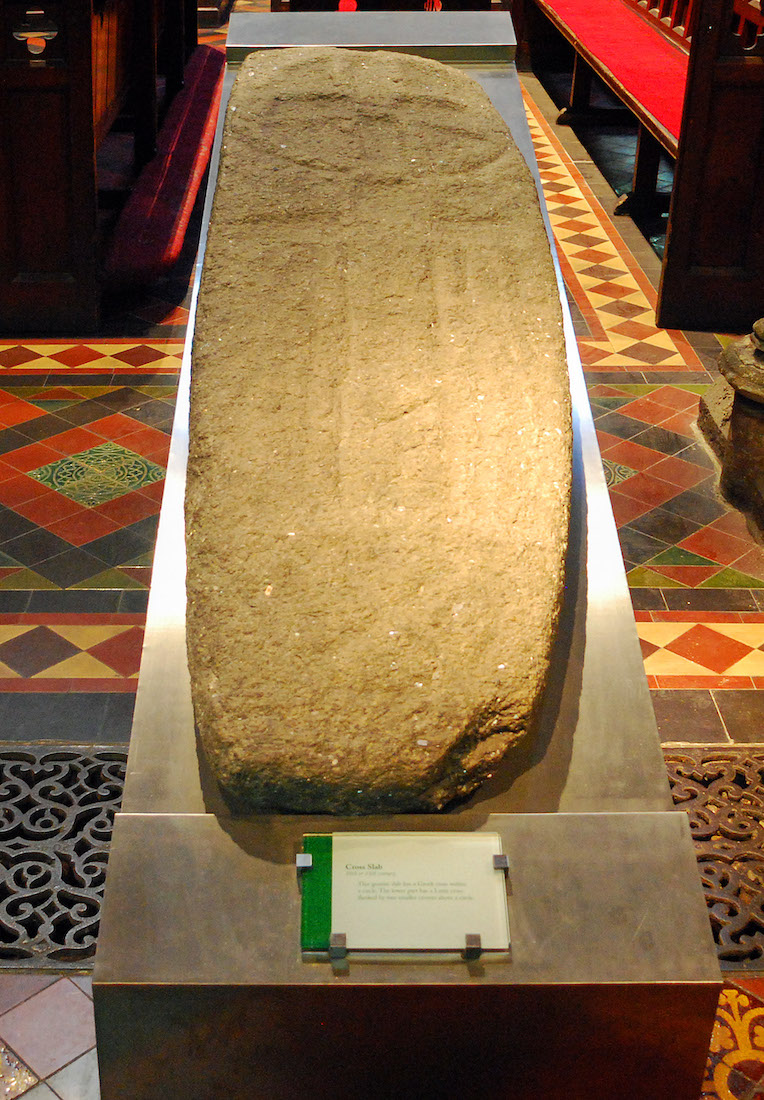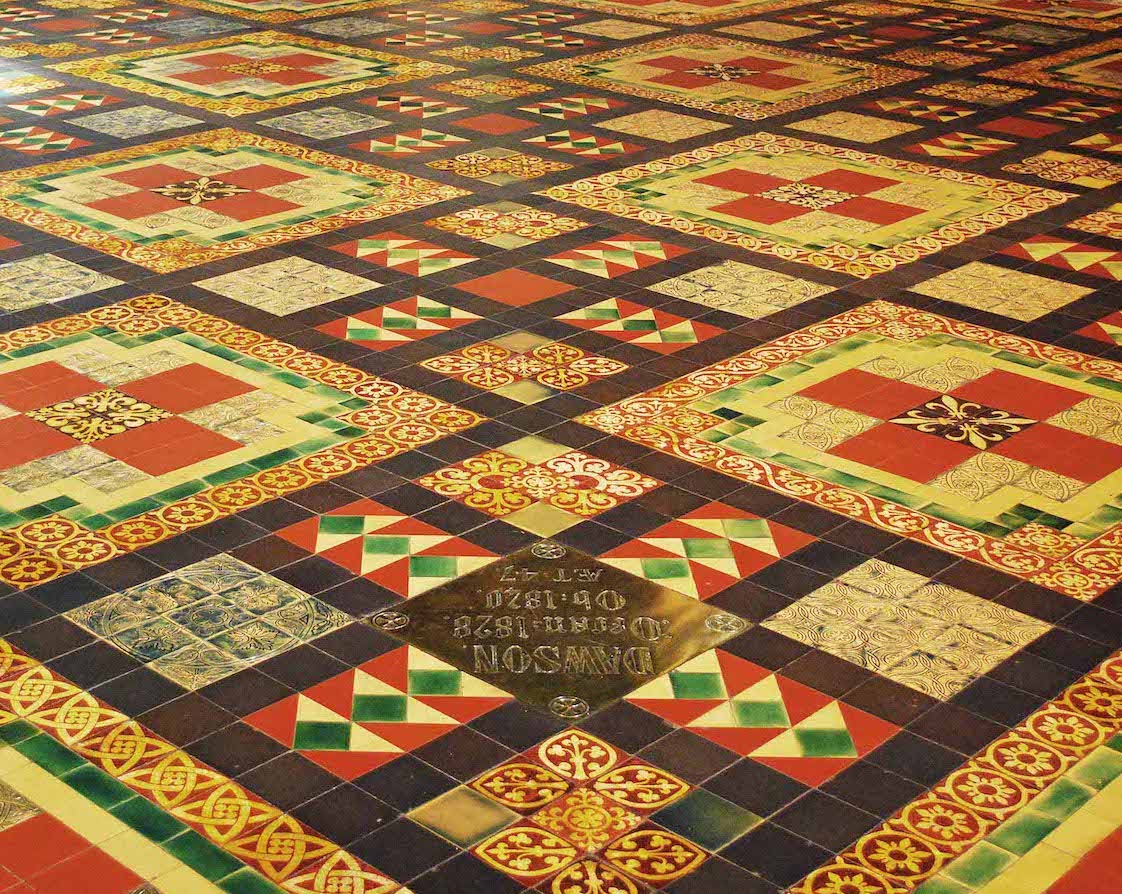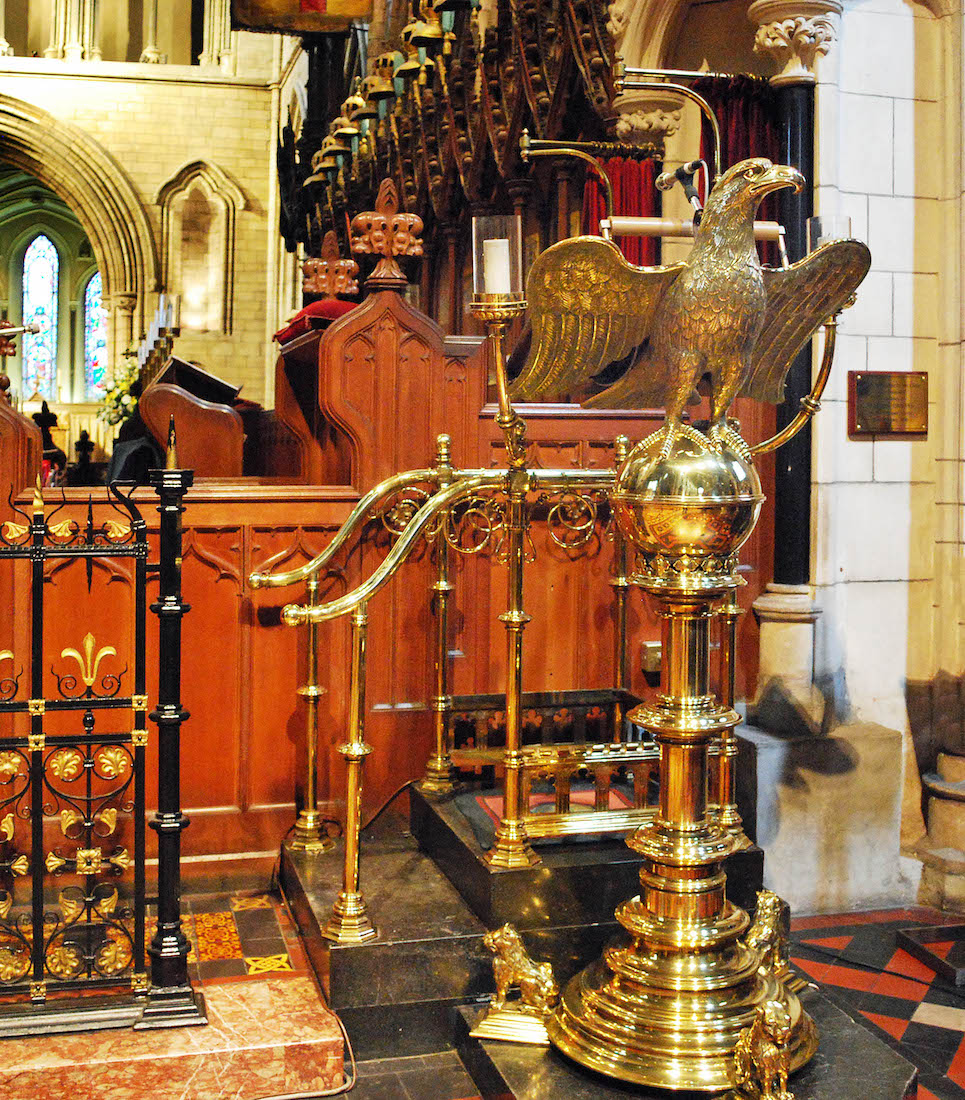

Located here in the South transept are a couple of ‘cross slabs’ – ancient stones bearing the image of a Celtic cross. INDEX
82. TABLE AND PULPIT LM LM


This table and pulpit were once in a church where Jonathan Swift officiated as Dean.
83. SOUTH NAVE WINDOWS WG(X4)




There are four windows along the South nave wall, shown here from East to West. •• The Parable of the Good Samaritan, 1882, Hardman & Co., Birmingham. •• Erin Crowning Balfe, 1879, James Ballantine & Son, Edinburgh. Michael William Balfe (1808 –) was an early Irish composer. In the window, Erin is leaning on a harp. •• King David, 1864, James Ballantine & Son, Edinburgh. •• King David, 1875, William Wailes, Newcastle-upon-Tyne.
84. SOUTH NAVE AISLE LM LM
Here is the South nave aisle looking to the East. There are many monuments on the wall to the right, and a special cabinet in the left foreground.
85. MEMORIALS LM LM
The detailed plaque at left remembers the Officers and Men of the 8th King’s Royal Irish Hussars killed during the South African Campaign 1900–1902. This conflict is remembered again at right.
86. CROSS LM
A little further along this wall is this attractive memorial Celtic cross in memory of Sir Samuel Ferguson (1810 – 1886).
87. JONATHAN SWIFT MEMORABILIA LM LM
The cabinet contains various memorabilia of Jonathan Swift (1667–1745), who was well know as a writer (‘Gulliver’s Travels’), and also one-time dean of St Patrick’s Cathedral. In the winter of 1729 – 1730 Swift was awarded the freedom of Dublin city by special grace. This was the highest honour the city could bestow on him.
88. JONATHAN SWIFT GRAVE LM
Jonathan Swift (1667 – 1745) is buried inside the cathedral: his grave and memorail are right close to the Southwest entrance. He is buried close to Esther Johnson (known as Stella in his writings) who died twelve years before him. Swift first met Stella when he tutored her as part of his duties as private secretary to Sir William Temple. (She was only 16 years old.) The exact nature of their relationship has never been fully established. Swift, who never married, was devoted to Stella and wrote a number of poems for her including On Stella’s Birthday and Stella’s Distress.
89. KNEELERS LM LM
We now make our way to the front of the nave. Like many cathedral’s, St Patrick’s has many colourful kneelers – the handiwork of the ladies of the Cathedral.
90. CROSSING LM
At the front of the nave is the crossing – the area where the transepts cross the axis of the Cathedral. The floor is covered with more of the Cathedral’s brilliant tiling. To the East a wonderful wrought iron railing in black and gold separates crossing from chancel. And to the sides are the pulpit and lectern.
91. PULPIT LM LM
The pulpit is made of Caen stone with columns of Irish marble. It was commissioned by Sir Benjamin Lee Guinness in memory of Dean Pakenham. It dates from 1864,and is in High Victorian style. The sermon is preached from the pulpit week by week.
92. LECTERN LM LM
The lectern is the stand from which the scriptures are proclaimed during the Liturgy. The lectionary book rests on the outspread wings of a golden eagle suggesting the majesty and power of the Word of God.
93. CHOIR STALLS LM LM
The choir stalls of this Cathedral are very ornate with insignia at the back of the stalls, and a knight’s helmet and sword above each stall. The Choir stalls once served as a Chapel to ‘The Most Illustrious Order of the Knights of Saint Patrick’. This organisation was founded by King George III of England in 1783. It was an order of chivalry and the title of ‘Knight of the Order’ was given to its members. The ceremonies for the investment (introduction) of new knights into the order took place in Saint Patrick’s Cathedral until 1869. Members of noble Irish families swore loyalty to the King in order to be installed as Knights of the Order.
94. CHOIR AREA LM
A slightly more distant view of the choir stalls reveals the ‘knightly flags’ or banners hanging above. All very grand!
95. EASTERN VIEW LM
If we return to the crossing and study the choir, we become aware of the colonnaded end wall of the nave with its triforium arcade, and set of high windows above.
96. HIGH EASTERN WINDOWS SPC
The high Eastern windows of the apse are difficult to discern or interpret. The central figure appears to be St Patrick, and the two small outer figures are angels. The remaining two figures are likely to be Irish saints.
98. HIGH ALTAR W-P
A final view of the high altar, here with a different frontal. This completes our tour of St Patrick’s Cathedral. [Photo Credit: Wikimedia Pilgab]

CONCLUSION LM
I hope you have enjoyed visiting this amazing Cathedral with me. As with all these old cathedrals, preparing a comprehensive website on St Patrick’s Cathedral is an almost impossible task – perhaps a life’s work! Here I have been conscious of the many monuments which have gone unrecognized.
Most of the photos on this site have been freely supplied by ‘Le Monde1’ [LM], and it has been a great pleasure working with him. The photos can be found on the Flickr website with link:
https://www.flickr.com/photos/31068574@N05/albums/72157624250444668/
I have also used window photos and explanations from the Gloine site which appears under Wikimedia [WG]:
https://www.gloine.ie/search/window/14609/W01
St Patrick’s Cathedral has a large number of windows, and my site has depended greatly on this source.
I have used several drone photos by Erik Clark [EC]. These have been taken from his excellent video, found at:
https://www.youtube.com/watch?v=UzwboNpnKWw
Finally, many of my navigational photos, and some others, have been taken from Google Street View [GSV].
Smaller numbers of photos have been drawn from other sources, and these are acknowledged in the text. I am grateful to all who have contributed to this site.
If there are any errors, I would like to know: the best websites are those without errors. As usual with my websites, I take little credit for the text, and have drawn on many other sources.
I am very grateful to my wife Margaret who has proof-read this site, and who helps me finalize all my websites.
St Patrick’s Cathedral website has link
https://www.stpatrickscathedral.ie
Paul Scott Site created 03 / 2024
mail@paulscott.info
























